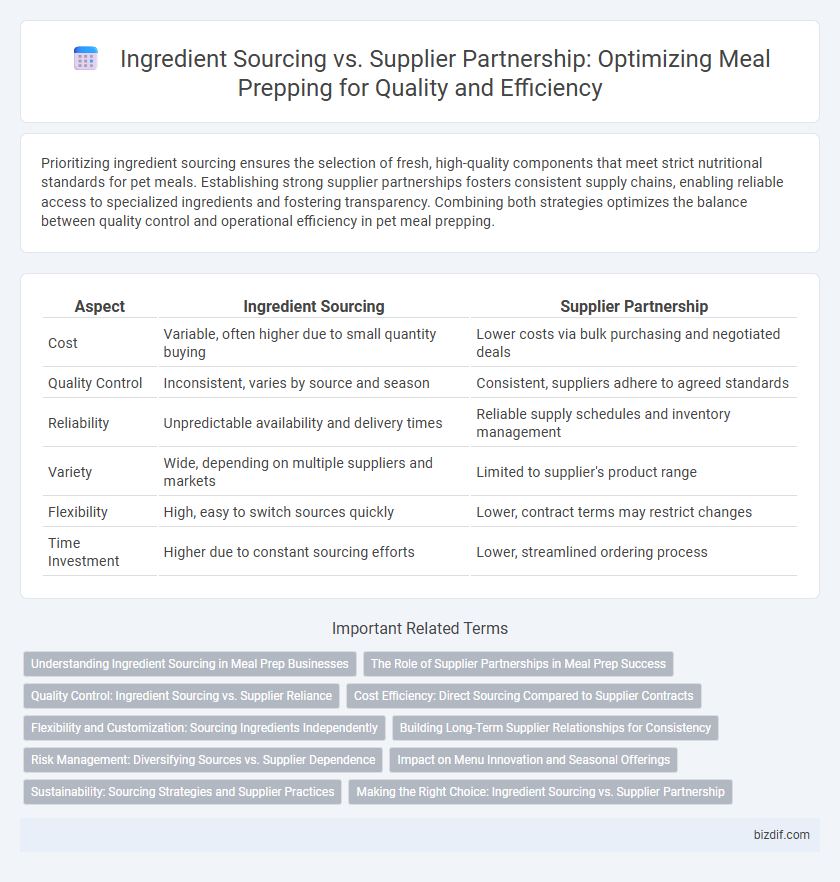Prioritizing ingredient sourcing ensures the selection of fresh, high-quality components that meet strict nutritional standards for pet meals. Establishing strong supplier partnerships fosters consistent supply chains, enabling reliable access to specialized ingredients and fostering transparency. Combining both strategies optimizes the balance between quality control and operational efficiency in pet meal prepping.
Table of Comparison
| Aspect | Ingredient Sourcing | Supplier Partnership |
|---|---|---|
| Cost | Variable, often higher due to small quantity buying | Lower costs via bulk purchasing and negotiated deals |
| Quality Control | Inconsistent, varies by source and season | Consistent, suppliers adhere to agreed standards |
| Reliability | Unpredictable availability and delivery times | Reliable supply schedules and inventory management |
| Variety | Wide, depending on multiple suppliers and markets | Limited to supplier's product range |
| Flexibility | High, easy to switch sources quickly | Lower, contract terms may restrict changes |
| Time Investment | Higher due to constant sourcing efforts | Lower, streamlined ordering process |
Understanding Ingredient Sourcing in Meal Prep Businesses
Ingredient sourcing in meal prep businesses involves selecting high-quality, fresh, and sustainable raw materials directly from local farms, markets, or trusted suppliers to ensure consistent flavor and nutritional value. Understanding the origin, seasonal availability, and authenticity of ingredients helps optimize menu planning, control costs, and maintain food safety standards. Prioritizing ingredient sourcing over supplier partnerships allows greater flexibility in adapting recipes and meeting customer preferences in dynamic market conditions.
The Role of Supplier Partnerships in Meal Prep Success
Supplier partnerships play a crucial role in meal prep success by ensuring consistent access to high-quality ingredients, which directly impacts flavor and nutritional value. Reliable suppliers provide transparency in sourcing, enabling meal preppers to meet dietary standards and customer expectations effectively. Strong partnerships also facilitate cost management and timely delivery, supporting efficient meal prep operations and scalability.
Quality Control: Ingredient Sourcing vs. Supplier Reliance
Quality control in meal prepping hinges on the distinction between ingredient sourcing and supplier partnerships, where direct sourcing allows for stringent inspections and selection of fresh, high-grade components. Relying on established suppliers may streamline procurement but often reduces transparency, potentially compromising ingredient consistency and safety. Ensuring rigorous quality checks and cultivating reliable supplier relationships are critical to maintaining ingredient integrity and meal quality.
Cost Efficiency: Direct Sourcing Compared to Supplier Contracts
Direct ingredient sourcing often reduces costs by eliminating supplier markups and allowing bulk purchases from producers. Supplier partnerships provide consistent quality and negotiated pricing but may include added fees and less flexibility in price adjustments. Balancing these options can optimize cost efficiency in meal prepping by leveraging direct sourcing for staple ingredients and supplier contracts for specialty items.
Flexibility and Customization: Sourcing Ingredients Independently
Sourcing ingredients independently offers unparalleled flexibility and customization, allowing meal preppers to select fresh, local, and organic produce tailored to specific dietary needs and flavor profiles. This approach enables dynamic adjustments based on seasonal availability and individual preferences, which supplier partnerships may restrict due to fixed contracts and bulk ordering constraints. Independent sourcing enhances control over ingredient quality and diversity, supporting personalized meal prep plans and dietary goals.
Building Long-Term Supplier Relationships for Consistency
Securing consistent ingredient quality in meal prepping depends heavily on cultivating strong supplier partnerships rather than one-time ingredient sourcing. Long-term relationships with suppliers enable predictable delivery schedules, cost stability, and access to fresher, high-quality produce essential for reliable meal production. Investing in these partnerships supports scalability and reduces supply chain disruptions, ensuring meal prep businesses maintain consistent taste and nutrition standards.
Risk Management: Diversifying Sources vs. Supplier Dependence
Diversifying ingredient sourcing enhances meal prepping risk management by reducing vulnerability to supply chain disruptions and price fluctuations. Relying solely on a single supplier increases dependency risks, potentially causing delays and quality inconsistencies. Establishing multiple supplier partnerships ensures consistent ingredient availability and safeguards against market volatility.
Impact on Menu Innovation and Seasonal Offerings
Ingredient sourcing from diverse local farms encourages menu innovation by providing access to fresher, seasonal produce that inspires creative dishes and seasonal offerings. Supplier partnerships ensure consistent quality and reliable delivery schedules, enabling chefs to plan innovative menus confidently around seasonal availability. Combining local sourcing with strong partnerships enhances flexibility and responsiveness in menu development, driving unique seasonal offerings that attract discerning customers.
Sustainability: Sourcing Strategies and Supplier Practices
Sustainable meal prepping relies on ingredient sourcing from suppliers committed to eco-friendly practices such as organic farming, reduced pesticide use, and minimal packaging waste. Developing supplier partnerships focused on transparency and fair labor ensures ethical impact throughout the supply chain while reducing carbon footprints. Prioritizing locally sourced, seasonal ingredients enhances freshness and supports sustainable agriculture, aligning sourcing strategies with environmental responsibility.
Making the Right Choice: Ingredient Sourcing vs. Supplier Partnership
Choosing between ingredient sourcing and establishing supplier partnerships significantly impacts meal prepping efficiency and quality. Ingredient sourcing offers flexibility and access to a variety of fresh, seasonal products, while supplier partnerships ensure consistent supply, better pricing, and customized quality standards. Evaluating factors such as cost control, ingredient traceability, and long-term reliability helps meal prep businesses optimize operations and maintain high culinary standards.
Ingredient Sourcing vs Supplier Partnership Infographic

 bizdif.com
bizdif.com